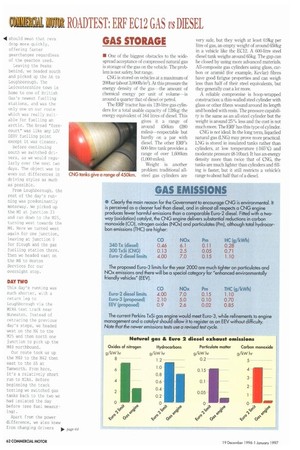GAS STORAGE
Page 64

If you've noticed an error in this article please click here to report it so we can fix it.
• One of the biggest obstacles to the widespread acceptance of compressed natural gas is storage of the gas on the vehicle. The problem is not safety, but range.
CNG is stored on vehicles at a maximum of 200bar (about 3,0001b/in2). At this pressure the energy density of the gas-the amount of chemical energy per unit of volume-is around a quarter that of diesel or petrol.
The ERF tractor has six 120-litre gas cylinders for a total usable capacity of 128kg: the energy equivalent of 164 litres of diesel. This gives it a range of around 450km (280 miles)-respectable but hardly on a par with diesel. The other ERF's 600-litre tank provides a range of over 1,600km (1,000 miles).
Weight is another problem: traditional allsteel gas cylinders are very safe, but they weigh at least 0.9kg per litre of gas, an empty weight of around 650kg in a vehicle like the EC12. A 600-litre steel diesel tank weighs around 65kg. The gap can be closed by using more advanced materials. All-composite gas cylinders using glass, carbon or aramid (for example, Kevlar) fibres have good fatigue properties and can weigh less than half of their steel equivalents, but they generally cost a lot more.
A reliable compromise is hoop-wrapped construction: a thin-walled steel cylinder with glass or other fibres wound around its length and bonded with resin. The pressure capability is the same as an all-steel cylinder but the weight is around 25% less and the cost is not much more. The ERF has this type of cylinder.
CNG is not ideal. In the long term, liquefied natural gas (LNG) may prove more practical. LNG is stored in insulated tanks rather than cylinders, at low temperature (-165°C) and moderate pressure (8-10bar). It has an energy density more than twice that of CNG, the tanks are much lighter than cylinders and filling is faster, but it still restricts a vehicle's range to about half that of a diesel.








































































































































